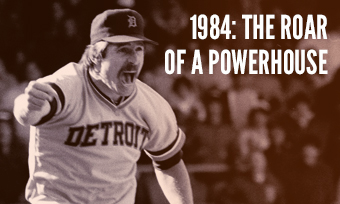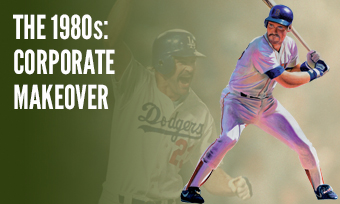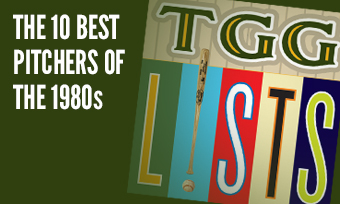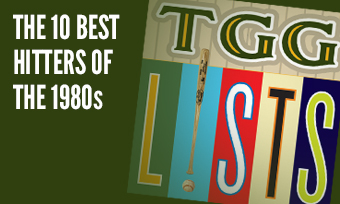The Yearly Reader
Leaders and Honors, 1984
Our list of baseball’s top 10 hitters and pitchers in both the American League and National League for the 1984 baseball season, as well as the awards and honors given to the game’s top achievers of the year.
The National League’s Top 10 Hitters, 1984
Bold type in brick red indicates league leader.
1. Ryne Sandberg, Chicago
Key Numbers: .314 average, 114 runs, 200 hits, 36 doubles, 19 triples, 19 home runs, 84 RBIs, 32 stolen bases.
Not since Ernie Banks in 1959 had the Cubs boasted of an MVP until Sandberg came along; Ryno’s 19 triples were the most by a Cub since Vic Saier (21) in 1913.
2. Tim Raines, Montreal
Key Numbers: .309 average, 106 runs, 192 hits, 38 doubles, 9 triples, 8 home runs, 60 RBIs, 87 walks, 75 stolen bases.
Aping an early career trend, Raines ran hot down the stretch—stealing more than half of his bases (39) over the season’s final two months.
3. Dale Murphy, Atlanta
Key Numbers: 162 games, .309 average, 94 runs, 176 hits, 32 doubles, 8 triples, 36 home runs, 100 RBIs, 20 intentional walks, 19 stolen bases, .547 slugging percentage.
Murphy failed in his quest to win a third straight MVP, but he was never more valuable to Braves teammates who underperformed—they hit .241 and slugged .338 without him, numbers which would have made them dead last in the majors.
4. Mike Schmidt, Philadelphia
Key Numbers: .277 average, 93 runs, 36 home runs, 106 RBIs, 92 walks.
With most of the aging star talent that surrounded him a year earlier gone, Schmidt seemed refreshed with a new crop of youngsters (Juan Samuel, Von Hayes) who would help give brief life to the Phillies’ offense.
5. Leon Durham, Chicago
Key Numbers: 137 games, .279 average, 86 runs, 30 doubles, 23 home runs, 96 RBIs, 16 stolen bases.
It’s a shame that Cubs fans will remember Durham for his crucially bad NLCS defense than for the fine numbers he posted beforehand that helped get Chicago to its first postseason since 1945.
6. Jose Cruz, Houston
Key Numbers: .312 average, 96 runs, 187 hits, 28 doubles 13 triples, 12 home runs, 95 RBIs,22 stolen bases, 10 sacrifice flies.
Deadball times in the Astrodome? At age 37, Cruz collected more triples than home runs—and led the team in both departments. It gets stranger; all 12 of Cruz’s homers came on the road.
7. Gary Matthews, Chicago
Key Numbers: .291 average, 101 runs, 14 home runs, 82 RBIs, 103 walks, 17 stolen bases, 10 sacrifice flies, .410 on-base percentage.
In his last full-time season at age 34, Matthews provided a below-the-radar contribution to the playoff-bound Cubs.
8. Tony Gwynn, San Diego
Key Numbers: .351 average, 88 runs, 213 hits, 21 doubles, 10 triples, 5 home runs, 71 RBIs, 33 stolen bases, .410 on-base percentage.
A big-time breakout for the future Hall of Famer, collecting his first of eight batting titles; he hit .386 against NL West foes.
9. Juan Samuel, Philadelphia
Key Numbers: .272 average, 701 at-bats, 105 runs, 191 hits, 36 doubles, 19 triples, 15 home runs, 69 RBIs, 168 strikeouts, 72 stolen bases.
The Dominican-born rookie put up Ryne Sandberg-like numbers, but lost the MVP vote for his wretched defense at second base—and because he played for the .500 Phillies. Still, someone thought he was a better rookie than Dwight Gooden and gave him a sole first-place vote in the Rookie of the Year race.
10. Chili Davis, San Francisco
Key Numbers: 137 games, .315 average, 87 runs, 21 doubles, 6 triples, 21 home runs, 81 RBIs, 12 stolen bases.
In his third full major-league season, the Jamaican switch-hitter was the Giants’ best hitter amid a sound offense on, overall, a very bad (66-96) team.
The American League’s Top 10 Hitters, 1984
1. Eddie Murray, Baltimore
Key Numbers: 162 games, .306 average, 97 runs, 180 hits, 26 doubles, 29 home runs, 110 RBIs, 107 walks, 25 intentional walks, 10 stolen bases, .410 on-base percentage.
Murray hung with super-ironman teammate Cal Ripken Jr., playing all 162 games alongside him; no one else would be able to do that in the 15 years Ripken failed to sit out.
2. Dwight Evans, Boston
Key Numbers: 162 games, .295 average, 121 runs, 186 hits, 37 doubles, 8 triples, 32 home runs, 104 RBIs, 96 walks.
Evans returned to prominence among AL hitters after an injury-marred .238 showing in 1983.
3. Dave Winfield, New York
Key Numbers: .340 average, 106 runs, 193 hits, 34 doubles, 19 home runs, 100 RBIs.
How competitive was Winfield and breakout teammate Don Mattingly? A day after Mattingly had his first 5-hit game as a Yankee, Winfield had his first such effort in pinstripes—and doubled down with his second just two days later.
4. Don Mattingly, New York
Key Numbers: .343 average, 91 runs, 207 hits, 44 doubles, 23 home runs, 110 RBIs.
An actual home-grown Yankee who George Steinbrenner managed not to give away for another over-the-hill veteran, Mattingly received the cheers as he won his sole AL batting title over teammate Dave Winfield—who received the boos—by collecting four hits on the season’s final day.
5. Rickey Henderson, Oakland
Key Numbers: .293 average, 113 runs, 27 doubles, 16 home runs, 58 RBIs, 86 walks, 66 stolen bases.
Rickey would finish his first (and longest) of four separate tenures in an A’s uniform as, for the moment, a close second behind Bert Campaneris on the franchise’s all-time stolen base list despite playing just six seasons to date.
6. Lloyd Moseby, Toronto
Key Numbers: .280 average, 97 runs, 28 doubles, 15 triples, 18 home runs, 92 RBIs, 78 walks, 39 stolen bases.
In a well-balanced, ever-improving Toronto lineup, Moseby remained the most reliable.
7. Kirk Gibson, Detroit
Key Numbers: .282 average, 92 runs, 23 doubles, 10 triples, 27 home runs, 91 RBIs, 29 stolen bases.
The rough-and-tumble star finally played every day for the first time in six years, leading many to wonder in retrospect: Why did it take the Tigers’ brass so long to figure him out?
8. Mike Easler, Boston
Key Numbers: .313 average, 121 runs, 186 hits, 31 doubles, 5 triples, 27 home runs, 91 RBIs.
A legitimate hitting threat, frustrated in Pittsburgh because the Pirates typically sat him against southpaws, Easler was dealt to the Red Sox and showed he could play every day.
9. Alvin Davis, Seattle
Key Numbers: .284 average, 80 runs, 34 doubles, 27 home runs, 116 RBIs, 97 walks.
Sudden big-league stardom may have humbled the modest Davis—a Class-AA player one year earlier—but not his Rookie-of-the-Year numbers in Seattle, which included an MLB-record 47 straight games reaching base to start his career. And consider the competition for rookie honors: Roger Clemens, Kirby Puckett, Mark Gubicza and Mark Langston.
10. Cal Ripken Jr., Baltimore
Key Numbers: 162 games, .304 average, 103 runs, 195 hits, 37 doubles, 7 triples, 27 home runs, 86 RBIs.
On May 6 at Texas, Ripken hit for the only cycle of his career.
The National League’s Top 10 Pitchers, 1984
1. Rick Rhoden, Pittsburgh
Key Numbers: 2.72 ERA, 14 wins, 9 losses, 33 starts, 238.1 innings, 10 wild pitches.
A terrific athlete, Rhoden—who with a zero handicap at golf could have made it in the PGA—pitched well over the last two-plus months (7-2 2.24 ERA) and hit very well, batting .450 (18-for-40) during the same stretch.
2. Dwight Gooden, New York
Key Numbers: 2.60 ERA, 17 wins, 9 losses, 31 starts, 218 innings, 276 strikeouts, 7 balks, 47 stolen bases allowed.
Some might look at all of the above and ask: Why is Rhoden ahead of Gooden? For starters, there’s all those extra bases he conceded when runners stole at will against him. And remember: Strikeouts are just outs by another name.
3. Bruce Sutter, St. Louis
Key Numbers: 1.54 ERA, 5 wins, 7 losses, 45 saves, 8 blown saves, 71 appearances, 122.2 innings, 23 walks, 18 grounded into double plays.
Sutter put his relief game back in high gear after stalling (4.23 ERA) the year before.
4. Orel Hershiser, Los Angeles
Key Numbers: 2.66 ERA, 11 wins, 8 losses, 2 saves, 2 blown saves, 45 appearances, 20 starts, 4 shutouts, 189.2 innings.
Moved from the bullpen at the end of June, the rookie Hershiser gave a preview of things to come by completing the season’s longest streak of consecutive scoreless innings in the majors, at 34.1.
5. Alejandro Pena, Los Angeles
Key Numbers: 2.48 ERA, 12 wins, 6 losses, 28 starts, 4 shutouts, 199.1 innings.
Pena took his time on the mound so often, it’s a miracle he got in as many starts as he did; he certainly made the most of it, pacing the NL in ERA and shutouts before shoulder surgery crippled his next couple of seasons, followed by a transition to long-time reliever.
6. Joaquin Andujar, St. Louis
Key Numbers: 3.34 ERA, 20 wins, 14 losses, 36 starts, 4 shutouts, 261.1 innings, 7 hit-by-pitches. 30 stolen bases allowed.
Despite bouncing back strong from a hard-luck 6-16 campaign in 1983, Andujar believed he didn’t win the NL Cy Young Award because he was Dominican. (Late arrival Rick Sutcliffe, 16-1 with the Cubs after a midseason trade, was given the honor.)
7. Rick Honeycutt, Los Angeles
Key Numbers: 2.84 ERA, 10 wins, 9 losses, 28 starts, 183.2 innings, 24 grounded into double plays.
After failing to help the Dodgers out late in 1983 following a splendid start in Texas, Honeycutt made up with a solid showing that deserved a better record.
8. John Denny, Philadelphia
Key Numbers: 2.45 ERA, 7 wins, 7 losses, 22 starts, 154.1 innings, 29 walks.
The reigning NL Cy Young winner retained the skills that gained him the honor, but lost his luck; his ERA was 2.75 when he didn’t get a decision, and 2.84 when he lost.
9. Mario Soto, Cincinnati
Key Numbers: 3.53 ERA, 18 wins, 7 losses, 13 complete games, .720 win percentage, 237.1 innings, 32 stolen bases allowed.
Soto may have been one of the NL’s best, but also one of its most hostile—being the focal point of two vicious brawls during the season, both earning him five-day suspensions. Maybe he was upset about the no-hitter that got away; on May 12, the Cardinals’ George Hendrick ruined the no-no bid with a two-out, ninth-inning home run.
10. Jesse Orosco, New York
Key Numbers: 2.59 ERA, 10 wins, 6 losses, 31 saves, 8 blown saves, 60 appearances, 87 innings.
In the early stage of his career where he was averaging close to two innings per appearance—as opposed to roughly half an inning by the time he threw his final pitch in 2003, at age 46—Orosco followed up a career-high 13 wins in 1983 with 10, his second-highest total.
The American League’s Top 10 Pitchers, 1984
1. Willie Hernandez, Detroit
Key Numbers: 1.92 ERA, 9 wins, 3 losses, 32 saves, 1 blown save, 80 appearances, 140.1 innings.
With a regal strut, Hernandez was nicknamed The King—and in 1984, he certainly pitched like one.
2. Dave Stieb, Toronto
Key Numbers: 2.83 ERA, 16 wins, 8 losses, 35 starts, 267 innings, 198 strikeouts, 11 hit-by-pitches.
In what was became something of a habit, the Toronto workhorse led the AL in ERA going into the season’s final week—but lost it with a pair of subpar starts. He’d make up and win it the next year.
3. Mike Boddicker, Baltimore
Key Numbers: 2.79 ERA, 20 wins, 11 losses, 34 starts, 16 complete games, 261.1 innings, 24 stolen bases allowed, 25 grounded into double plays.
Take away the relievers, and Boddicker was the best pitcher in the AL—except maybe Dave Stieb.
4. Bert Blyleven, Cleveland
Key Numbers: 2.87 ERA, 19 wins, 7 losses, .731 win percentage, 32 starts, 245 innings.
Blyleven fumed that his resurrection from a long string of injuries didn’t get him traded from lowly Cleveland to a contender a la Rick Sutcliffe. He’d get his wish the next season with a transfer to Minnesota.
5. Bud Black, Kansas City
Key Numbers: 3.12 ERA, 17 wins, 12 losses, 35 starts, 257 innings.
Black shined as a saving grace within a Royals rotation that flattened out (42-56, 4.60 ERA) without him.
6. Geoff Zahn, California
Key Numbers: 3.12 ERA, 13 wins, 10 losses, 27 starts, 5 shutouts, 199.1 innings, 0 stolen bases allowed, 10 caught stealing/picked off, 27 grounded into double plays.
Forget the marquee stats—it was the peripherals that boosted Zahn’s efficiency, allowing few long hits, many double play grounders and no stolen bases at age 38.
7. Dan Quisenberry, Kansas City
Key Numbers: 2.64 ERA, 6 wins, 3 losses, 44 saves, 9 blown saves, 72 appearances, 129.1 innings, 12 walks.
Finishing the season one save short of his own major league mark of the year before, Quisenberry was clearly the reason the Royals were lifted from mediocrity to a dubious (84-78) AL West title. Thus, he finished third in the AL MVP vote.
8. Storm Davis, Baltimore
Key Numbers: 3.12 ERA, 14 wins, 9 losses, 1 save, 1 blown save, 35 appearances, 31 starts, 225 innings, 21 grounded into double plays.
Named after a character in a book his mother was reading before his birth, Storm caused havoc on opponents in his third year at Baltimore.
9. Doyle Alexander, Toronto
Key Numbers: 3.13 ERA, 17 wins, 6 losses, .739 win percentage, 35 starts, 261.2 innings.
Have arm, will travel: The Doyle Alexander Story, now playing at Toronto as one of 10 stops in his 19-year career.
10. Frank Viola, Minnesota
Key Numbers: 3.21 ERA, 18 wins, 12 losses, 35 starts, 257.2 innings.
One of the many “Twinkee” rookies from their 1982 campaign (60-102) at the brand-new Metrodome, Viola suddenly emerged as a legit ace after going 11-25 with a 5.38 ERA over his first two seasons.









